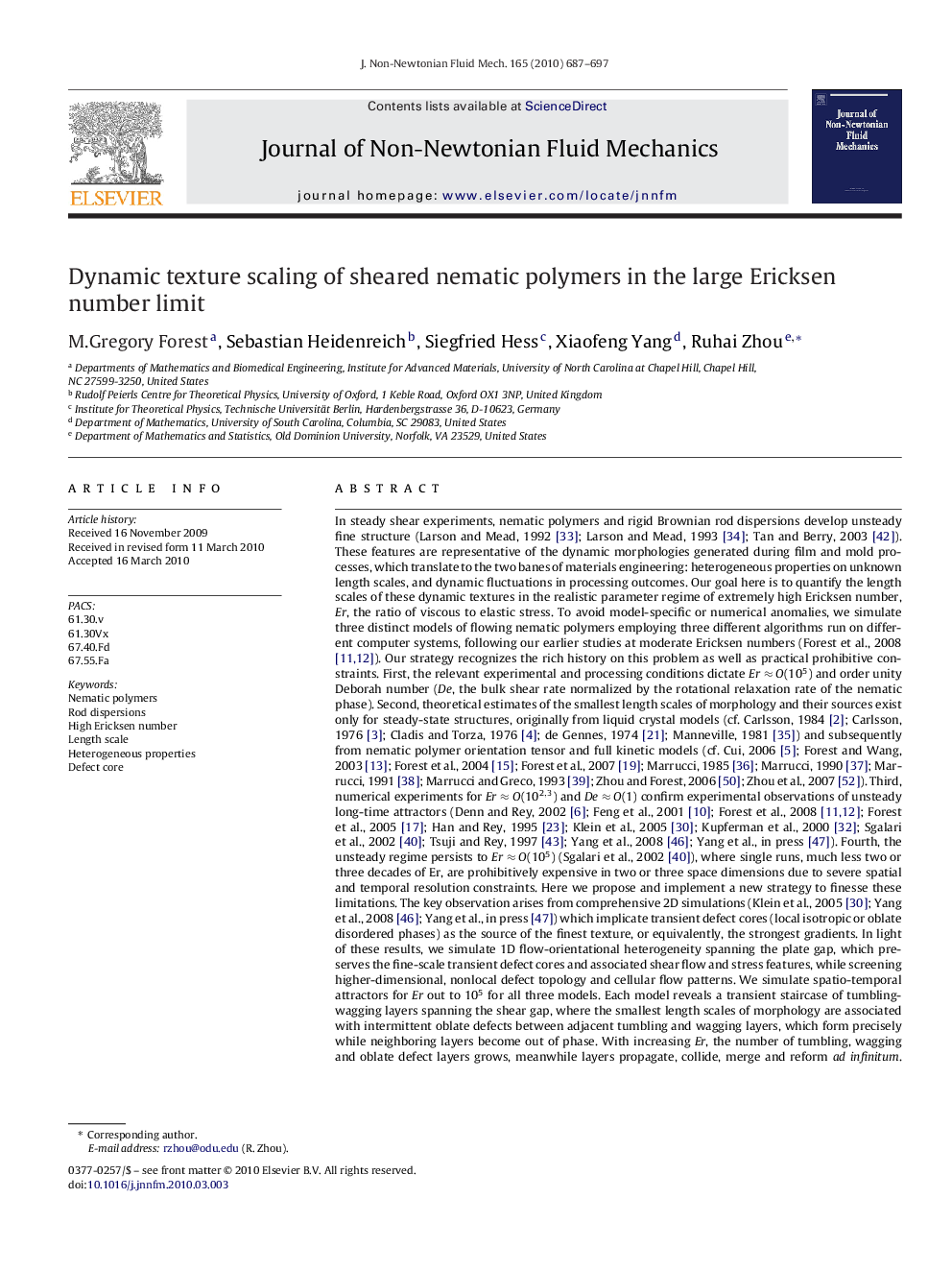| کد مقاله | کد نشریه | سال انتشار | مقاله انگلیسی | نسخه تمام متن |
|---|---|---|---|---|
| 671049 | 1459077 | 2010 | 11 صفحه PDF | دانلود رایگان |

In steady shear experiments, nematic polymers and rigid Brownian rod dispersions develop unsteady fine structure (Larson and Mead, 1992 [33]; Larson and Mead, 1993 [34]; Tan and Berry, 2003 [42]). These features are representative of the dynamic morphologies generated during film and mold processes, which translate to the two banes of materials engineering: heterogeneous properties on unknown length scales, and dynamic fluctuations in processing outcomes. Our goal here is to quantify the length scales of these dynamic textures in the realistic parameter regime of extremely high Ericksen number, Er, the ratio of viscous to elastic stress. To avoid model-specific or numerical anomalies, we simulate three distinct models of flowing nematic polymers employing three different algorithms run on different computer systems, following our earlier studies at moderate Ericksen numbers (Forest et al., 2008 [11] and [12]). Our strategy recognizes the rich history on this problem as well as practical prohibitive constraints. First, the relevant experimental and processing conditions dictate Er≈O(105)Er≈O(105) and order unity Deborah number (De, the bulk shear rate normalized by the rotational relaxation rate of the nematic phase). Second, theoretical estimates of the smallest length scales of morphology and their sources exist only for steady-state structures, originally from liquid crystal models (cf. Carlsson, 1984 [2]; Carlsson, 1976 [3]; Cladis and Torza, 1976 [4]; de Gennes, 1974 [21]; Manneville, 1981 [35]) and subsequently from nematic polymer orientation tensor and full kinetic models (cf. Cui, 2006 [5]; Forest and Wang, 2003 [13]; Forest et al., 2004 [15]; Forest et al., 2007 [19]; Marrucci, 1985 [36]; Marrucci, 1990 [37]; Marrucci, 1991 [38]; Marrucci and Greco, 1993 [39]; Zhou and Forest, 2006 [50]; Zhou et al., 2007 [52]). Third, numerical experiments for Er≈O(102,3)Er≈O(102,3) and De≈O(1)De≈O(1) confirm experimental observations of unsteady long-time attractors (Denn and Rey, 2002 [6]; Feng et al., 2001 [10]; Forest et al., 2008 [11] and [12]; Forest et al., 2005 [17]; Han and Rey, 1995 [23]; Klein et al., 2005 [30]; Kupferman et al., 2000 [32]; Sgalari et al., 2002 [40]; Tsuji and Rey, 1997 [43]; Yang et al., 2008 [46]; Yang et al., in press [47]). Fourth, the unsteady regime persists to Er≈O(105)Er≈O(105) (Sgalari et al., 2002 [40]), where single runs, much less two or three decades of Er, are prohibitively expensive in two or three space dimensions due to severe spatial and temporal resolution constraints. Here we propose and implement a new strategy to finesse these limitations. The key observation arises from comprehensive 2D simulations (Klein et al., 2005 [30]; Yang et al., 2008 [46]; Yang et al., in press [47]) which implicate transient defect cores (local isotropic or oblate disordered phases) as the source of the finest texture, or equivalently, the strongest gradients. In light of these results, we simulate 1D flow-orientational heterogeneity spanning the plate gap, which preserves the fine-scale transient defect cores and associated shear flow and stress features, while screening higher-dimensional, nonlocal defect topology and cellular flow patterns. We simulate spatio-temporal attractors for Er out to 105105 for all three models. Each model reveals a transient staircase of tumbling-wagging layers spanning the shear gap, where the smallest length scales of morphology are associated with intermittent oblate defects between adjacent tumbling and wagging layers, which form precisely while neighboring layers become out of phase. With increasing Er, the number of tumbling, wagging and oblate defect layers grows, meanwhile layers propagate, collide, merge and reform ad infinitum. To quantify these dynamic textures, we calculate a time-averaged morphology length scale distribution function , defined by the reciprocal of the gradient of the oblate defect metric. The peak of this PDF characterizes a dominant morphology length scale which, for all three models, remarkably adheres to the Marrucci scaling law Er−(1/2)Er−(1/2), consistent with earlier numerical studies (Sgalari et al., 2002 [40]) on yet another nematic flow-tensor model. This result yields an a priori estimate for the finest length scales in shear-dominated nematic polymer films and molds based on processing conditions and Frank elasticity constants, which confirms a prediction of Marrucci, 25 years ago (Marrucci, 1985 [36]), based on dimensional analysis in the dynamic tumbling regime.
Journal: Journal of Non-Newtonian Fluid Mechanics - Volume 165, Issues 13–14, July 2010, Pages 687–697